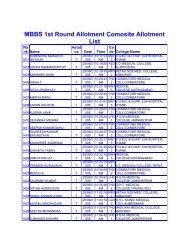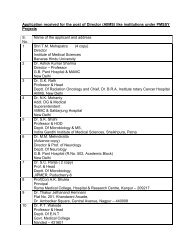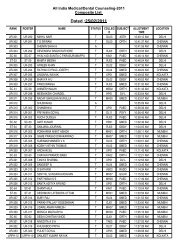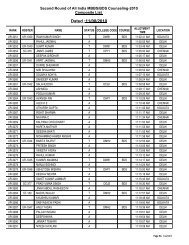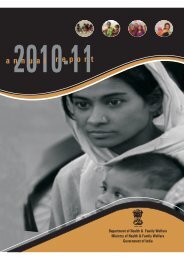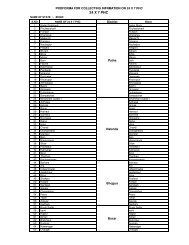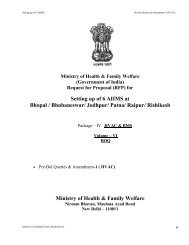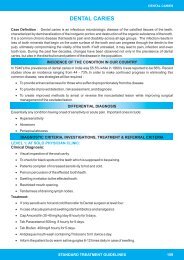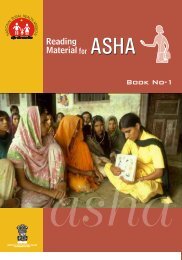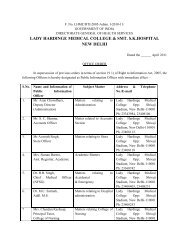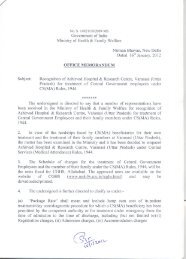National Vaccine Policy Book - Ministry of Health and Family Welfare
National Vaccine Policy Book - Ministry of Health and Family Welfare
National Vaccine Policy Book - Ministry of Health and Family Welfare
Create successful ePaper yourself
Turn your PDF publications into a flip-book with our unique Google optimized e-Paper software.
1.3. Process adopted in the development <strong>of</strong> this document<br />
The working group constituted by Dr. N.K. Ganguly in Sept. 2010<br />
started to develop an initial draft <strong>of</strong> this policy document. The working<br />
group had a series <strong>of</strong> meetings, reviewed a number <strong>of</strong> policy,<br />
program <strong>and</strong> operational documents. The first draft was completed<br />
<strong>and</strong> shared with NTAGI members for comments in February 2011.<br />
The comments from NTAGI members <strong>and</strong> subsequent revision were<br />
done in March 2011.<br />
2. POLICY CONTEXT AND FRAMEWORK<br />
This document covers all categories <strong>of</strong> vaccine, vaccines being used<br />
in UIP, vaccines available but not part <strong>of</strong> UIP (both new <strong>and</strong><br />
underutilized), <strong>and</strong> those vaccines, which are likely to become<br />
available in the future. The document also touches the aspects<br />
related to vaccine security in the country <strong>and</strong> vaccination program in<br />
broader framework <strong>of</strong> <strong>National</strong> <strong>Health</strong> <strong>Policy</strong> <strong>of</strong> India.<br />
2.1. Current UIP vaccines<br />
UIP in India <strong>and</strong> its core antigens have made a significant impact on<br />
the burden <strong>of</strong> diseases in the country <strong>and</strong> directly contributed to<br />
reducing child mortality. However, the regular production <strong>and</strong> supply<br />
<strong>of</strong> these vaccines, in a setting where majority <strong>of</strong> manufacturers are<br />
increasingly paying attention to the newer vaccines is a big<br />
challenge. There is limited production capacity <strong>of</strong> these vaccines in<br />
public sector units <strong>and</strong> the involvement <strong>of</strong> private sector<br />
manufacturers is required to ensure that supply <strong>of</strong> UIP vaccine is not<br />
threatened.<br />
2.2. New <strong>and</strong> under-utilized vaccines<br />
There are a number <strong>of</strong> new vaccines, which have become part <strong>of</strong><br />
<strong>National</strong> Immunization Programs (NIPs) in many developing <strong>and</strong><br />
developed countries. Many a times, the decision to introduce these<br />
vaccines is delayed due to limited production capacity, which<br />
indirectly affects the price <strong>of</strong> these vaccines too. Sometimes<br />
vaccines are not used as these are not indigenously produced or not<br />
available in sufficient quantity. On the other h<strong>and</strong>s, the<br />
manufacturers don’t produce vaccine because these are not used in<br />
the program. The authorities should use innovative financing,<br />
funding <strong>and</strong> assured supply mechanisms to overcome these<br />
challenges. Furthermore, there is need for the institutionalizing <strong>and</strong><br />
strengthening <strong>of</strong> decision making process <strong>and</strong> enhancing<br />
confidence <strong>of</strong> the people in the process besides preparing in-built<br />
country mechanism for sustainable production <strong>of</strong> newer vaccines<br />
within country.<br />
2.3. Potentially new vaccines<br />
The diseases which are prevalent in developing countries are <strong>of</strong>ten<br />
different than the ones in developed countries. However, till last<br />
decade majority <strong>of</strong> the vaccine research was being done in<br />
developed countries <strong>and</strong> the focus was on the vaccines against<br />
diseases, which are prevalent in developed country setting. India has<br />
a leading vaccine industry; however, there is need for investing more<br />
on the research for the vaccines for the priority diseases in the<br />
country. Such research can be promoted only when there is<br />
conducive environment, funding <strong>and</strong> subsequent chances <strong>of</strong> vaccine<br />
being introduced in the <strong>National</strong> program.<br />
2.4. <strong>Vaccine</strong> security <strong>and</strong> other issues<br />
India should be able to ensure quality, safety, <strong>and</strong> efficacy <strong>of</strong> all<br />
vaccines that are either indigenously produced or imported for the<br />
use in the country. Achieving this requires a robust regulatory<br />
mechanism to be in place. Furthermore, the implementation <strong>of</strong><br />
immunization program should be put in the perspective <strong>of</strong> broader<br />
goals <strong>of</strong> <strong>National</strong> <strong>Health</strong> <strong>Policy</strong>. The sufficient political will & support,<br />
<strong>and</strong> the necessary sufficient <strong>and</strong> sustainable financing mechanisms<br />
should also be ensured for this purpose.<br />
3. SITUATION ANALYSIS<br />
3.1. Burden <strong>of</strong> VPDs <strong>and</strong> their surveillance<br />
Since the beginning <strong>of</strong> EPI in India, there has been a general decline<br />
in the reported number <strong>of</strong> cases <strong>of</strong> the main VPDs (diphtheria,<br />
tetanus, pertussis <strong>and</strong> measles).<br />
The overarching goal <strong>of</strong> vaccine use is to reduce morbidity <strong>and</strong><br />
mortality due to vaccine preventable diseases (VPD). While<br />
surveillance information for specific VPD is limited, trends in Infant<br />
Mortality Rate (IMR) to reflect the impact <strong>of</strong> vaccination suggest that<br />
IMR in India has fallen steadily to reach 50 deaths per 1000 livebirths<br />
(SRS 2009).<br />
04 05




